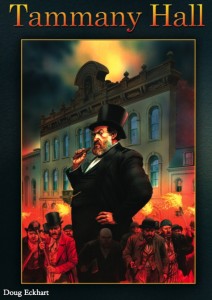Thoughts On: Tammany Hall
Posted by James (admin) on October 15th, 2010
 In Tammany Hall, players place their ward bosses to try to win the support of the migrant nation entering New York so that they will be voted in as mayor. There are 4 different migrant nations – each represented by different colour cubes (different to the player colours). In essence, Tammany Hall is an area control game but has some interesting elements that take it a bit further with hidden voting and role allocation.
In Tammany Hall, players place their ward bosses to try to win the support of the migrant nation entering New York so that they will be voted in as mayor. There are 4 different migrant nations – each represented by different colour cubes (different to the player colours). In essence, Tammany Hall is an area control game but has some interesting elements that take it a bit further with hidden voting and role allocation.
Each turn, a player either places two of their ward bosses in New York’s regions, or they place one of their ward bosses plus place one of the migrants (cubes) who want to enter New York. If a player places a migrant from those currently queuing, they also receive a political favour cube of that nationality. A game lasts 16 turns (16 years) and there is an election (scoring) after every 4 turns. During an election, each city area is assessed and player’s who have ward bosses in an area compete to win that area. Each ward boss is worth 1 vote and players can also (secretly) add any of their favour cubes which match any migrant nations represented in that area too. Winning an area scores 1 VP; also, plus the players who have the most migrant cubes of each nation present in the areas they control get 3 extra political favour tokens.
After an election, the player with the most VPs is the Mayor and they allocate a political office role to each of the other players. The Mayor has no powers other than allocating roles but the other roles each have an ability such as locking down an area of the city. At the end of the game there are 2 bonus VPs for the player’s with the most favour chips left of each nation, plus 1VP for each unused slander chip.
 Rather than be an average area control game, the different elements combine to deliver some very interesting mechanics giving Tammany Hall its own identity. The voting can be quite tense as players know how many favours their opponents could use but don’t know how many each other might bid (plus, once bid, the favours are used). Also, the city areas are resolved in a pre-determined order so you need to factor in which favours you may need in the areas yet to be resolved. Finally, you need to work out which areas to try to win based on the migrants present in each area. Placing two ward bosses is nicely balanced against placing one and determining where a migrant may go – especially as placing a migrant may be a good way of stopping a player who has a lot of favours with one nation muscling in on an area where you have control.
Rather than be an average area control game, the different elements combine to deliver some very interesting mechanics giving Tammany Hall its own identity. The voting can be quite tense as players know how many favours their opponents could use but don’t know how many each other might bid (plus, once bid, the favours are used). Also, the city areas are resolved in a pre-determined order so you need to factor in which favours you may need in the areas yet to be resolved. Finally, you need to work out which areas to try to win based on the migrants present in each area. Placing two ward bosses is nicely balanced against placing one and determining where a migrant may go – especially as placing a migrant may be a good way of stopping a player who has a lot of favours with one nation muscling in on an area where you have control.
The different roles in the city can make a big difference and, whilst the mayor has no power other than allocating the roles, giving them to the people who can do the least damage with them can make a big difference. As for the other players, using the roles can give a big advantage.
With only 4 turns before each vote, players have a very limited amount of turns in which to act – so, you’re always trying to work out the best way to utilise your precious actions, plus your plans may get disrupted by another player’s actions so you need to be able to think on your feet and respond. Whilst it was hard to work out what a good plan of action was at the start, Tammany Hall offered lots of interesting tactics to it as well as short-term strategies to devise. I definitely gave the wrong roles to players first time as I didn’t fully understand the power of their abilities at that point.
I wasn’t sure what to expect from Tammany Hall – it can look a little dry at first glance – but I really enjoyed it once we got into the rules and I definitely want to play it again.
James.
[Played with 4 players]


October 16th, 2010 at 3:26 am
Intriguing! This sounds like a fresh game. I’ll have to give it a look.